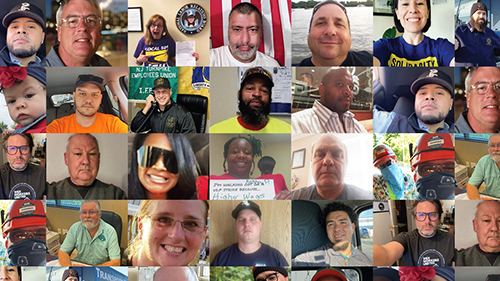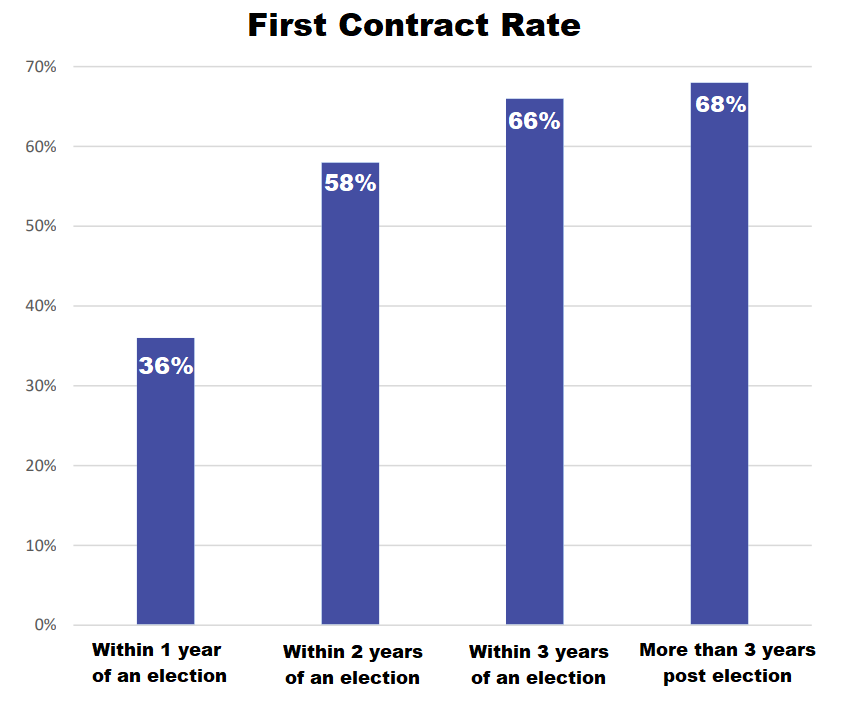En Español

Recently, the Department of Labor’s Bureau of Labor Statistics reported that union membership grew in the United States last year by more than a quarter of a million workers, with Black workers representing nearly all of this growth. That means more than 14.3 million workers are now members of unions.
This data reflects the growing interest among working people in forming a union at their workplace. But you would never know that from reading newspaper headlines when the BLS data was released. Many media outlets wrote headlines saying union membership went down, when it actually went up. Others focused on the overall share of the workforce who are union members, which fell slightly because the growth in union membership was dwarfed by unprecedented job growth during the Biden-Harris administration, including a record 4.5 million new jobs in 2022 alone. Union membership went up but hasn't caught up with overall job growth. It’s also important to note that the 2022 increase in the number of union members was significant and offset the decrease of 241,000 in 2021.
Interest in organizing is at historic levels. Election petitions are up 53% at the National Labor Relations Board and other labor relations agencies, and the union win rate is up, too.
Workers clearly want unions. Workers – particularly young workers and workers of color – are organizing at coffee shops, retail stores, universities, museum, nonprofits, tech companies, and other industries and sectors at a level we haven’t seen in decades. 60 million non-union workers say they would vote for a union today if given the chance.
More employers are seeing that their workers want a collective voice and are respecting their decision to organize by voluntarily recognizing their workers’ union and getting to the bargaining table. Employers like Microsoft, Major League Baseball, Conde Nast and more are staying out of the way when workers are deciding whether to organize and have agreed to respect their workers’ decision. This high road approach is commendable and hopefully will pave the way for even more employers following suit.
But why isn’t this groundswell of interest in organizing translating into even higher union membership growth numbers?
First, the process for organizing is too slow, especially when employers choose to fight rather than take the high road like Microsoft and others have done. Many of the organizing campaigns that caught fire in 2022 – or even 2021 – have not yet resulted in worker wins because workers have not yet had a chance to have a free, fair vote.

Second, many newly organized workers are still struggling to negotiate a first contract with their employer. Only 36% of newly organized units reach a first agreement within one year of organizing. Our law is weak when it comes to the bargaining process, which makes it that much more significant when companies react like Ultium recently did after workers overwhelmingly voted for UAW representation – the company said it respected the result and would get to the bargaining table. More companies should do the same.
Workers, employers, communities and our economy do better when workers have a collective voice through a union. The Biden-Harris administration supports workers who choose to exercise their right to organize, and we urge all employers to respect their workers’ choice and do the same.
Marty Walsh is the U.S. Secretary of Labor. Follow him on Twitter and Instagram at @SecMartyWalsh.
Lo que los titulares no te dicen sobre la membresía sindical
Por: Secretario Marty Walsh
La Oficina de Estadísticas Laborales del Departamento de Trabajo reportó recientemente que la membresía en sindicatos creció el año pasado en Estados Unidos en más de un cuarto de millón de trabajadores, y que trabajadores Negros representaron la casi totalidad de este crecimiento. Eso significa que más de 14,3 millones de trabajadores son en este momento miembros de sindicatos.
Estos datos reflejan el creciente interés de los trabajadores en formar un sindicato en sus lugares de trabajo. Pero usted no sabría esto únicamente leyendo los titulares de prensa que se publicaron cuando BLS anunció esos datos. Muchos medios de comunicación escribieron titulares indicando que la afiliación sindical disminuyó cuando, en realidad, fue exactamente lo contrario. Otros se centraron en la proporción de la fuerza laboral que hace parte de sindicatos. Esta proporción disminuyó levemente pero sólo porque el crecimiento en afiliación sindical resultó eclipsado por el crecimiento laboral sin precedentes registrado en la administración Biden-Harris, incluido un récord de 4,5 millones nuevos empleos apenas en el 2022. La afiliación sindical aumentó, pero no en paralelo al crecimiento general del empleo. También es importante subrayar que el aumento en el 2022 en el número de trabajadores miembros de sindicato fue significativo y compensó la disminución de 241,000 registrada en el 2021.
El interés en la organización de trabajadores está a niveles históricos. Las solicitudes para realizar elecciones sindicales aumentaron un 53% ante la National Labor Relations Board y otras agencias de relaciones patronal-sindicatos, y también aumentaron las tasas del sí a la sindicalización.
Los trabajadores claramente quieren sindicatos. Los trabajadores – particularmente jóvenes y de minorías – se están organizando a niveles que no hemos visto en décadas en cafeterías, tiendas, universidades, museos, organizaciones sin ánimo de lucro, empresas de tecnología y en otras empresas y sectores. 60 millones de trabajadores no sindicalizados han dicho que votarían por un sindicato si se les diera la oportunidad.
Más empleadores están viendo que sus trabajadores quieren una voz colectiva y están respetando su decisión, reconociendo voluntariamente a su sindicato y sentándose a negociar. Empleadores como Microsoft, Major League Baseball, Conde Nast y más se están manteniendo al margen cuando los trabajadores deciden si organizarse o no, y han establecido respetar la decisión de sus trabajadores. Este enfoque de altura es encomiable y con suerte allanará el camino para que más empleadores sigan su ejemplo.
Pero ¿por qué esta oleada de interés en organizarse sindicalmente no se traduce en cifras aún más altas de crecimiento en la membresía de trabajadores en sindicatos?
Primeramente, el proceso para organizarse es demasiado lento, especialmente cuando los empleadores optan por luchar en vez de tomar el camino de altura como han hecho Microsoft y otros. Muchas de las campañas de organización que se emprendieron en 2022, o incluso en 2021, aún no han resultado en victorias de los trabajadores porque estos aún no han tenido la oportunidad de tener un voto justo y libre.
En segundo lugar, muchos trabajadores recientemente organizados aún luchan con su empleador en la negociación de un primer contrato. Solo el 36% de las unidades recién organizadas llegan a un primer acuerdo en el primer año luego de haberse organizado. Nuestra ley es débil respecto al proceso de negociación colectiva, y por eso es muy significativo cuando empresas reaccionan como recientemente lo hizo Ultium luego de que los trabajadores votaran abrumadoramente por tener representación en la UAW: la empresa dijo que respetaba el resultado y que iría a la mesa de negociación. Más empresas deberían hacer lo mismo.
A trabajadores, empleadores, comunidades y a nuestra economía les va mejor cuando los trabajadores tienen una voz colectiva a través de un sindicato. La administración Biden-Harris apoya a los trabajadores que eligen ejercer su derecho a organizarse, e instamos a todos los empleadores a respetar la elección de sus trabajadores y hacer lo mismo.
Marty Walsh es el Secretario de Trabajo de EE.UU. Síguele por Twitter e Instagram con @SecMartyWalsh.

 U.S. Department of Labor Blog
U.S. Department of Labor Blog